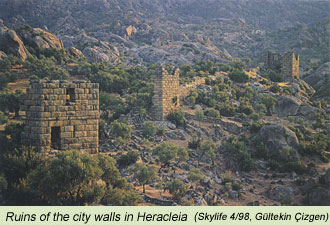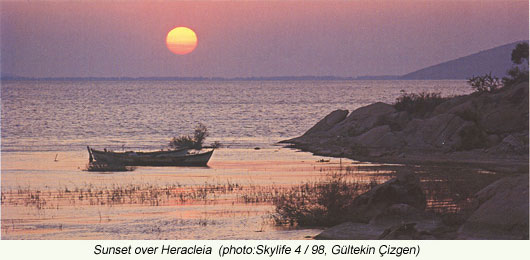Herakleia, with its splendid city wall and its fascinating landscape, is one of the most impressive Anatolian ruins dating partly from Hellenistic times. The site is easily accessible both from Lake Bafa and by land. A motorboat can be hired from the southern shore of Lake Bafa and a rough jeep-road leads from the village of Bafa to the ruins..
In the Greek period, Herakleia was connected with the sea. Roman ships used to enter the famous Aegean harbour of Herakleia through the delta of the River Meander, today’s Menderes. With its huge warehoses and hinterland producing the three sacred crops of the Mediterranean, olive oil, grape and figs, Herakleia was a major port. It is named after the mythological hero, Heracles. From Strabo, we learn that, in his time (ca. the last quarter of the first century B.C.), it still had an anchorage. Strabo reports also that it was first called Latmos, i.e., by the same name as the mountain which lies above it. It paid a tribute of one talent as a member of the Delian Confederacy in the fifth century B.C. Around the middle of the 4th century B.C., it was dominated temporarily by Maussollos and Artemisia II. Both in the Hellenistic and Roman periods, the city flourished and its prosperity must have come from sea-trade. Herakleia also blossomed during Early Christian and Byzantine times. The small romantic islands situated in Lake Bafa bear well-preserved churches and monasteries dating from the Early Christian and Byzantine periods.

Subsequently time, which leaves nothing unchanged, wrought its work here too. Alluvium carried by the Menderes built up the Soke Plain, which eventually extended so far that it blocked the mouth of the Latmos Gulf transforming it into a lake. This is Lake Bafa which today has an area of 65 square kilometres and is 25 metres deep.
Until recently the lake was famous for its carp, but its ecosystem is badly deteriorated today. Irrigation has reduced the amount of water being carried by the Menderes, resulting in a two-metre fall in the water level and increased salinity. The bird population, however, remains high, and includes such species as crested cormorants, pelicans, grey herons, flamingos, mallards, and numerous other varieties of gulls, ducks and other water birds.
Kapıkırı stands on the site of the ancient Herakleia, surrounded by the colossal boulders which leave no land suitable for cultivation but a few small meadows. Today the population of three hundred souls depend on tourism for a living.
The loneliness of the sand causeways linking former islands to the shore, and the ancient quarries which had supplied marble for the celebrated Temple of Apollo at Didyma arouses a strange sense of human insignificance. Long centuries ago when the lake was still part of the sea, ships had docked here to load up marble for Didyma. Upon their arrival, the marble blocks had been carried up to the temple site by oxen. But the temple was never completed, and those part which were built with destroyed by earthquakes.
When the moon is full it hangs over Lake Bafa like a silver tray, reminding us of the story of Selene, Goddess of the moon , who fell in love with the handsome shepherd Endymion on the shores of this lake. On the terrace of one of the open air restaurants on the lake shore, where steps cut into the rock by the Romans still remain, you can sip a glass of raki or wine and enjoy mullet cooked on a griddle accompanied by a delicious “coban salad”. Perhaps the Herakleians did much the same, you reflect, as the intervening time seems to slip away, bringing the past almost within reach.
Although Lake Bafa is known to all who pass this way, few stop to explore. Yet it is easier to reach Herakleia than it was a few years ago. The road has now been asphalted and reaches right into the village. The inhabitants are friendly and welcoming. So when you are in Turkey do not miss to explore Lake Bafa and Herakleia.
by Gultekin Cizgen, “Skylife”, April 1998

